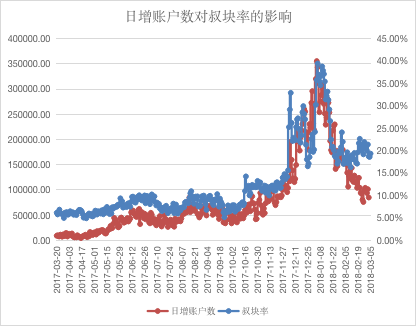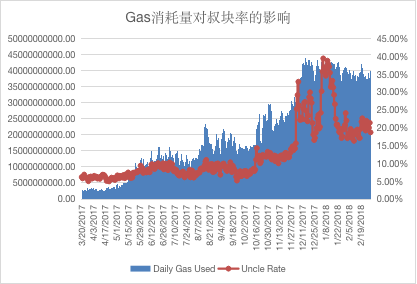The Uncle Block of the Ethereum Reward Mechanism (Part 2)
As mentioned in the previous article, the three factors of reward reduction, mining difficulty coefficient, and daily generation of ordinary blocks do not directly affect the number of uncle block /second block. Next, we will increase the user fee from the fee. The three dimensions of the number, daily trading volume and Gas consumption are statistically analyzed for the influence of the tertiary block rate.
1. Fee
Note: The study period is from March 2017 to March 2018 .

- Dry goods | read the solidity programming
- Bitcoin Lightning Network: Micro Payment Channel
- Uncle of the Ethereum Reward Mechanism (middle)
As shown in the above figure, the blue curve indicates the fluctuation of the unblock rate, and the red area indicates the fluctuation of the fee. It can be found that the fee and the unblock rate fluctuate in the same direction (that is, the unblock rate increases with the increase of the fee). , reduce and decrease), so the handling fee has a significant impact on the uncle block rate.
2. Daily increase in the number of users
Note: The study period is from March 2017 to March 2018 .

As shown in the above figure, the blue curve indicates the fluctuation of the unblock rate, and the red curve indicates the fluctuation of the number of daily accounts. It can be found that the number of daily accounts and the rate of the unblocks fluctuate in the same direction (ie, the rate of the unblock increases with the increase) The number of accounts increases and decreases, and decreases. Therefore, the number of daily accounts has a significant impact on the rate of uncle blocks.
3. Trading volume
Note: The study period is from March 2017 to March 2018 .

As shown in the above figure, the blue curve indicates the fluctuation of the unblock rate, and the red area indicates the fluctuation of the daily trading volume. It can be found that the trading volume fluctuates in the same direction as the unblocking rate (that is, the uncle block rate increases with the trading volume). Increase, decrease and decrease), so the daily trading volume has a significant impact on the uncle block rate.
In summary, it can be speculated that the surge in the number of accounts has led to an increase in transaction volume, which has led to high commissions, while attracting miners to compete for blocks and increasing the rate of uncles.
4. Gas consumption
Vitalik analyzed in Uncle Rate and Transaction Fee Analysis that the more transactions a block packs, the longer it takes for the network to spread, and the greater the likelihood that the block will become a block, then the average zone The gas consumption of the block is an important factor affecting the rate of the unblock. It is estimated by linear regression that if the average block gas consumption is between 100,000 and 300,000 , the uncle rate is stable between 6% and 8% . For every transaction in which the packaged block is increased by 1,000,000 gas , the probability of becoming a block is increased by about 1.86% . Therefore, the average block's gas consumption has a direct impact on the unblock rate.
Note: The study period is from March 2017 to March 2018 .

As shown in the above figure, the red curve indicates the fluctuation of the unblock rate, and the blue area indicates the fluctuation of the daily gas consumption. It can be found that during the rising period of the consumption of the gas , the unblock rate fluctuates in the same direction (ie, the unblock rate). As the consumption of gas increases, it decreases and decreases. When the gas consumption is close to the Gas Limit (ie, the trading heyday / congestion period ), there is a significant fluctuation in the unblock rate.
Based on the above analysis, the three factors of handling fee, daily account number, daily trading volume and gas consumption will have a direct impact on the tertiary block rate.
Previous article: Uncle's block of the Ethereum reward mechanism (on)
Uncle of the Ethereum Reward Mechanism (middle)
We will continue to update Blocking; if you have any questions or suggestions, please contact us!
Was this article helpful?
93 out of 132 found this helpful
Related articles
